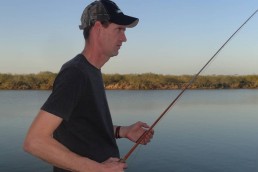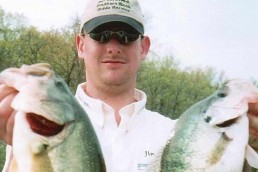Fly Fishing for Largemouth Bass
SHARE THIS POST
A few years ago when I was living in Wyoming I was introduced to the art of tying flies and fly fishing. Moving back to the Midwest, fly fishing was not as popular as it is in the West. But if I wanted to continue to fish in this fashion I’d have to adapt. Adapt is what I did, and before long I was catching largemouths with regularity.
Because of the fish’s size and where they live, your bass fly rodding equipment needs to be stouter than what is normally used for general trout fishing. I prefer a fly rod of 8 to 9 or more feet in length that will handle either a 7- or 8-weight line. The rod must be fairly stiff for casting bulky flies commonly used for bass and for moving fish away from the thick cover they’re often found in.
For fishing in shallow water, the floating line is your best friend. But to be on the safe side, have some sinking lines on hand in case the fish move to cooler, deeper water. The leaders used should be fairly short, about 7 feet or more with a strong tippet in the 6- to 10-pound range. The stronger the tippet, the better the chances are of pulling these bass out of the thick cover.
It is known that bass will eat just about anything. For this reason, both surface and sub-surface flies can be used. There will be times for each one to be used, but the surface poppers are without a doubt one of the best baits. Much like when a muskie explodes the surface to engulf a topwater lure and your heart seems to stop, the same is true when a bass explodes the surface to inhale a twitched popper.
Surface flies are mainly popping bugs meant to imitate frogs and other creatures that enter the water from above. These flies come in a variety of sizes and shapes. The slight indentation at the front of the popper is what causes the fly to pop as it comes across the water’s surface.
Are you enjoying this post?
You can be among the first to get the latest info on where to go, what to use and how to use it!
Different anglers have different techniques when fishing a popper. I’ve found the best is putting the fly in the desired location and quickly snapping the rod tip up, giving the first “pop” and grabbing the fish’s attention. After that, I twitch the rod back and forth, making the popper vibrate in the water. This is what normally causes a fish to strike. This twitching is important because it resembles a live bug in the water.
When fishing subsurface flies, these often resemble leeches, crawfish and other fish. When fishing these types, the hook should be in the 4 to 6 range with weed guards to prevent the hook from getting caught on weeds and other plants.
Even though the fly is very important, the retrieve is awful close to being just as critical. It takes some time to figure out which speed of retrieve will produce the strikes. Normally, you’ll notice that bass like a slower retrieve, but some days you will hardly be able to strip the line fast enough for what the bass like. Sometimes it is necessary to include hesitations with your retrieve to get a bass to strike.
It doesn’t matter if you choose to fish surface or sub-surface baits when going after a largemouth bass. One important piece of information that I must pass on is that for best results in spring and during pre- and post-spawning is when the bass move into the shallows to create their beds. Finding their spawning grounds is the first step in catching a bass with a fly.
Whether you are an experienced fly fisherman who has not yet pursued the largemouth with a fly rod or are new to the sport altogether, get out and give it a try. It’s one of the greatest things a fisherman can ever experience.
MWO
SHARE THIS POST
Did you enjoy this post?
You can be among the first to get the latest info on where to go, what to use and how to use it!
Jason Houser
Jason Houser is an avid outdoorsman from Central Illinois. Houser has been a full-time freelance writer since 2008. He is also the host of Jason Houser Outdoors, airing on the Hunt Channel. He can be found on Facebook at Jason Houser Outdoors or on the web at jasonhouseroutdoors.com.



